1. How are selective and divided attention different?
2. What role does attention play in controlled and automatic processing?
3. Describe the evidence that debunks the myth of multitasking.
4. What are the similarities and differences between the following theories of attention?
• filter and bottleneck theories
• early vs. late selection
• visual attention
5. What evidence is there for/against these theories?
6. What are three forms of inattention, and what are their effects?
• _________ attention: attending to a stimulus while ignoring others; also called focused attention
e.g., reading a textbook while trying to ignore interruptions
• _______ attention: attending to two or more simultaneous stimuli
e.g., driving, drinking a coffee, and talking on cell phone at the same time
Spelke, Hirst, & Neisser (1976): Can practice turn a controlled task into an automatic one?
- participants read stories while writing down words read aloud
- performance poor, but gradually improved
- after 6 weeks, people _____ both read and take dictation as well as either task alone
_________ |
__________ |
no attentional resources |
require resources |
occur without intention |
require conscious intention |
not available to consciousness |
conscious activities |
fast |
slow |
familiar, unchanging tasks |
may be novel, variable tasks |
no interference with other mental tasks |
produce interference with other mental tasks |
practiced, skilled responses |
rule-following responses |
The myth: Like computers, people are more efficient at getting things done when they perform multiple tasks at the same time.
Evidence:
• children perform worse on their homework if it is done while watching TV
• using a cell phone while driving degrades driving ability; even with practice, performance does not improve
• studies show that “multitaskers” actually just ______ rapidly between tasks (called task-switching, time-sharing, and multiplexing)
Rubinstein, Meyer, & Evans (2001): Is multitasking more efficient?
Experiment 1:
- multitasking group told to write a report and check their email at the same time
- second group told to complete one task before doing the other
- multitaskers took about 50% ______ than second group
Experiment 2:
- participants switched between solving math problems and classifying geometric figures
- the more difficult the problems and the more complex the rules used in sorting, the more time the participants lost in switching
- executive control has two distinct, complementary stages:
• ____ shifting: “I want to do this now instead of that”
• ____ activation: “I’m turning off the rules for that and turning on the rules for this”
- switching between tasks has a cost; repeated switching can add up--as much as 40% of a person’s productive time
Ophir, Nass, & Wagner (2009): What’s the difference between heavy- and light-multitaskers?
- participants: students who frequently performed media multitasking, and non-multitaskers
- tasks: computer-based working memory and attentional processing tasks
- heavy multitaskers did significantly worse than light multitaskers:
• more susceptible to ___________ items, which caused more errors
• less able to filter out irrelevant interference from interruptions
• performed more ______ on tasks that required them to quickly switch between tasks
- high-multitaskers adopt a breadth-biased strategy of information processing: attention is driven by external cues (called ________, a form of bottom-up processing)
- in contrast, attention can be controlled by higher-level cognition in service of a specific goal (called _________; top-down processing)
- but does multitasking cause--or is it caused by--the weaknesses in cognitive control shown by heavy multitaskers?
i.e., Does media-multitasking make people more distractible, or are people who are more easily distracted become media-multitaskers?
Just & colleagues (2001): What happens in the brain during multitasking?
- measured brain activity while participants:
a) did an auditory sentence comprehension task
b) mentally rotated a 3-D figure
- showed minimal task similarity: regions activated by each task barely __________
- when doing both tasks simultaneously:
• performance slowed down and errors increased
• brain activity was two-thirds ____ than the total devoted to both tasks when performed separately
- conclusion: the brain cannot simply double its efforts when there are two problems to solve at the same time
Dux, Marois, & colleagues (2009): What prevents the brain from multitasking?
- used fMRI scans when people were juggling two tasks
- __________ cortex appeared to deal with the tasks one by one, creating a mental bottleneck
- thus, limits on processing arose from slow processing in the prefrontal cortex, the brain’s central executive
Poldrack & colleagues (2006): How does multitasking affect learning?
- participants learned a simple card classification task by trial and error, while in fMRI scanner:
• control group learned without distractions
• experimental group performed task while also listening to high and low beeps, counting the number of high beeps
- no difference in classification performance
- however, experimental group was not able to ___________ their knowledge to new cards
- focused attention during learning activated the ___________--used in declarative (explicit) memory formation
- learning while multitasking activated the ________--used in habit learning, which is applied less flexibly in new situations
Problems with “multitasking”:
![]() it slows us down: reduces productivity
it slows us down: reduces productivity
![]() it hampers creativity: interruptions decrease creative thinking
it hampers creativity: interruptions decrease creative thinking
![]() it causes stress: increases release of stress hormones
it causes stress: increases release of stress hormones
Better plan (Dean & Webb, 2011):
![]() focus: set aside time/place to concentrate
focus: set aside time/place to concentrate
![]() filter: turn off gadgets/distractions
filter: turn off gadgets/distractions
![]() forget: make sure you get some downtime
forget: make sure you get some downtime
E. Colin Cherry (1953): How does attention process speech?
- ________ presentation: two different messages presented simultaneously to both ears
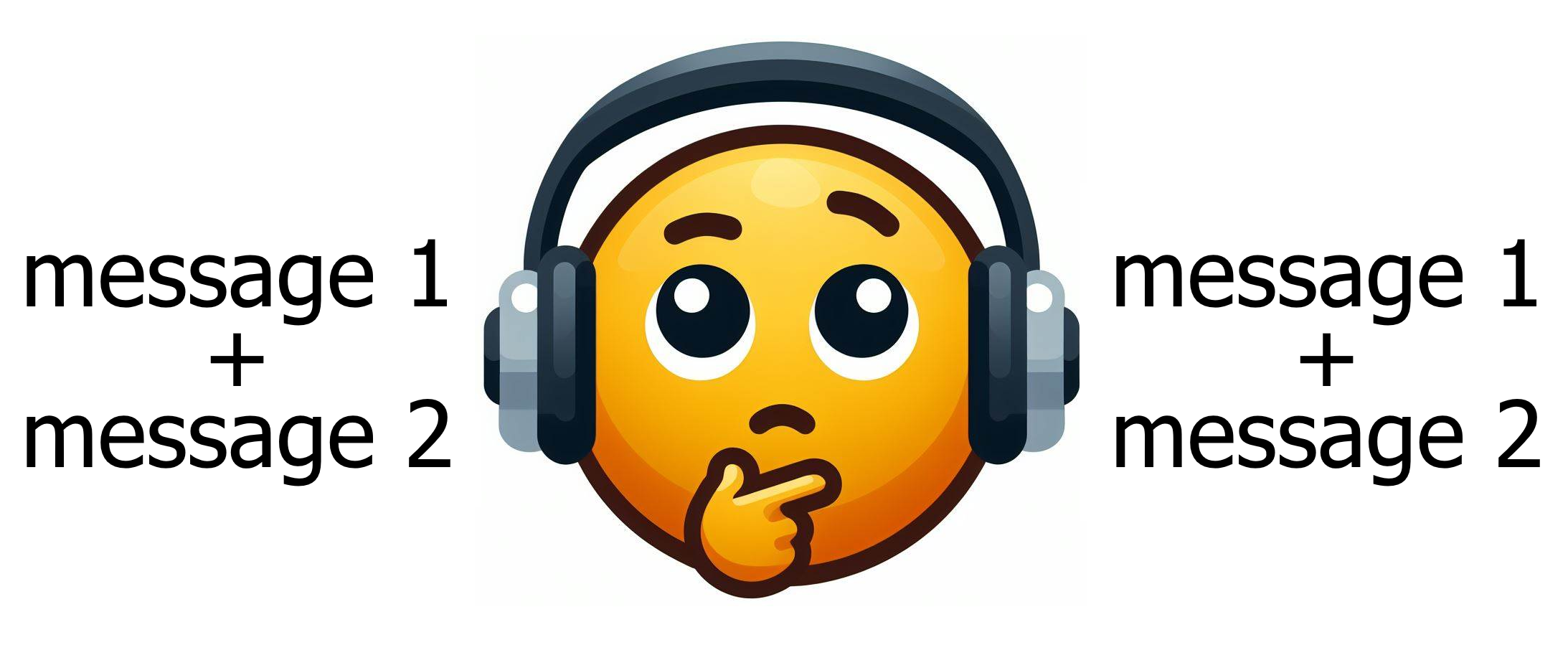
• almost impossible to ______ a single message (repeat out loud what you have just heard)
• practical problem: in the 1950s, air traffic controllers hearing multiple pilot messages over loudspeakers would get them mixed up
- ________ presentation: two different messages; one presented to each ear
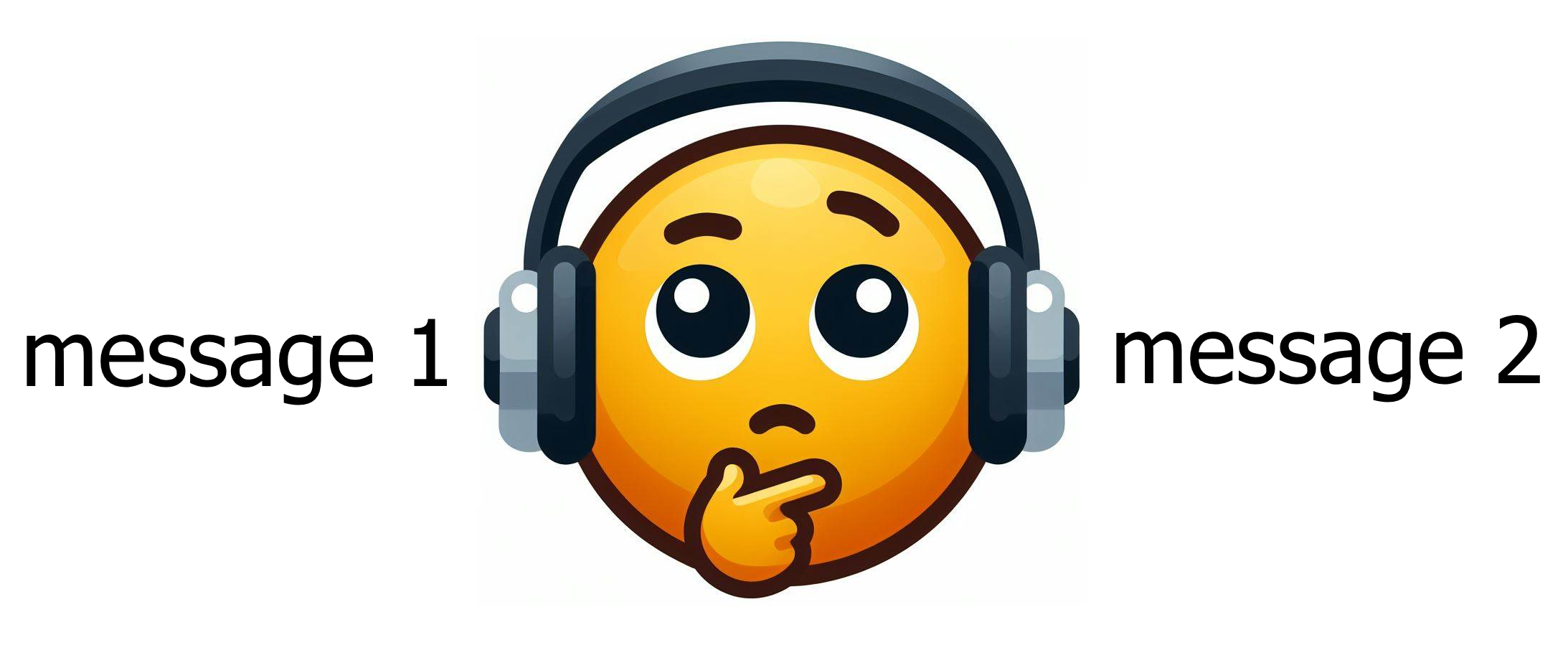
• participants accurately ________ messages
• could tell _______ characteristics from unattended ear: music/noise/speech; male/female voice
• no ________ (meaning-based) processing
- “________ _____” effect: the ability to selectively attend to one message while ignoring all other messages
e.g., having a conversation in the middle of a noisy party and not attending to others
• how is one message selected over others?
“how do we recognize what one person is saying when others are speaking at the same time (the ‘cocktail party problem’)?” (Cherry, 1953, pp. 975-976)
Filter Model (Donald Broadbent, 1958):
- _____ selection: information filtered before semantic analysis

- split-span (dichotic) experiment:
left ear: |
right ear: |
seven |
four |
four |
one |
three |
nine |
• recall digits by ear (7-4-3 or 4-1-9): __% correct
• recall the digits by pairs (7-4 or 4-1 or 3-9): 20% correct
- ________ attention uses energy, takes time; pairwise recall takes more attention
- multiple tasks performed by attention switching back and forth between them
- problems:
![]() Moray (1959):
Moray (1959):
• found that important information from unattended ear was processed (e.g., hearing “Fire!” or your name)
• suggests ____________ relevant content is not filtered out early on
![]() Gray & Wedderburn (1960):
Gray & Wedderburn (1960):
• Oxford undergraduates found ______ occurred in dichotic shadowing experiments
left ear: |
right ear: |
Dear |
nine |
seven |
Aunt |
Jane |
six |
• implies filtering not based on “________,” but on semantic properties
![]() Treisman (1960):
Treisman (1960):
• similar shadowing experiment
• message in attended ear was switched to unattended ear:
left ear: |
right ear: |
In the picnic basket she had peanut butter |
cat, large, day, apple, friend, every, select, |
book, leaf, roof, sample, always |
sandwiches and chocolate brownies... |
• participants momentarily ________ message to the other ear!
• conclusion: unattended signals are being analyzed
• incoming stimuli other than the target are __________ (weakened)
Attenuation Model (Treisman, 1964):
- attenuator analyzes stimuli on the basis of:
• physical characteristics
• language (syllables, words)
• meaning

- further processing occurs if information meets _______ recognition threshold in the “dictionary unit”
e.g., common words, high importance (your name or “Help!”), relevance/expectations (words that fit the current context)
- problem:
![]() MacKay (1973):
MacKay (1973):
• attended ear presented with sentence: “They threw stones toward the bank yesterday.”
• non-attended ear presented with words including “_____” or “_____”
• recognition task: 4.2% more likely to (incorrectly) recognize: “They threw stones toward the savings and loan association yesterday.” despite no memory for hearing “_____”
• information from unattended ear processed to the level of meaning; implies late selection
____ Selection Models (Deutsch & Deutsch, 1963; Norman, 1968):
- stimuli are filtered after processing based on their physical properties and meaning
- selection based on importance of recognized item, or meaning
- memory processes devoted to selected inputs

- problem:
![]() unlikely that all incoming stimuli are processed by deep semantic analysis
unlikely that all incoming stimuli are processed by deep semantic analysis
Johnston & Wilson (1980):
- participants heard word pairs, one of which was occasionally a word from a target category (e.g., animals)
- target words were ________ (e.g., “bear”)
- simultaneously paired nontarget word was:
• appropriate (e.g., “_________”)
• inappropriate (e.g., “_____”)
• or neutral (e.g., “luck”)
- _______ attention: observers not told which ear would get the target
• detection of targets improved with appropriate nontargets
• worse with inappropriate
- _______ (selective) attention: observers told which ear the target would appear in
• nontargets had no effect on target detection
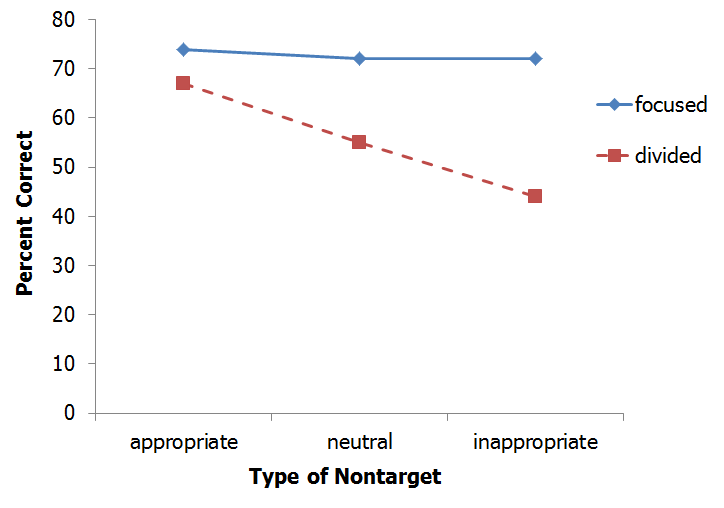
- amount of attention given to __________ was as much as needed to accomplish the task
_________ Theory (Johnston & Heinz, 1978):
- there may be ________ filters (preattentive and attentive)
- to minimize demands on capacity, early selection may occur, filtering out unnecessary stimuli (_________ attention)
- to evaluate a broad range of incoming information, late selection may occur (_______ attention)
_______ ___________ Theory (Treisman, 1986; Treisman & Gelade, 1980)
- Anne Treisman (b.1935, d.2018) won the 2009 Grawemeyer Award in Psychology, and received the 2011 US National Medal of Science
- attention must be focused on particular stimulus attributes or parts in space to construct a representation or percept
1. ____________ stage:
- rapid, automatic decomposition of stimulus into a number of basic properties (“primitives”)
- processing is in parallel
2. _______ attention stage:
- serial process
- spatial location selected, and primitives existing at this spot are combined
e.g., redness and X shape combined into red X
- combination object is called ______ ____; only exists temporarily to be examined by focused attention
Visual search:
- primitives determined via visual search experiments:
• task: find target among nontargets/“distractors”
• observers asked whether a display contains target
• RT (& errors) are recorded
- types of visual search:
• _______ search: target defined by one basic property/primitive
e.g., find a green 2 among red 2s
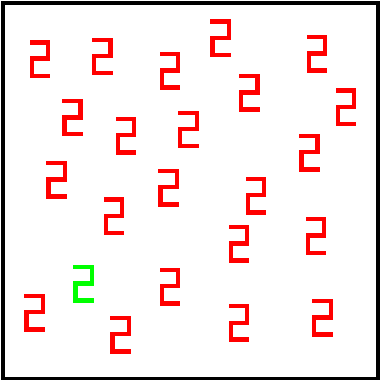
• ___________ search: target defined by a combination of two or more basic properties/primitives
e.g., find a green 5 among green and red 2s, and red 5s
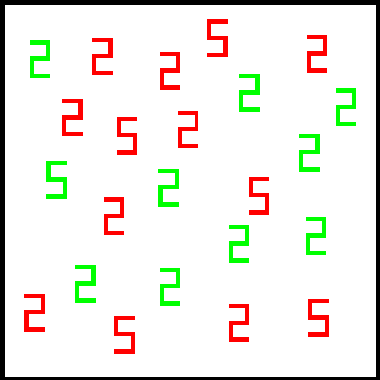
• spatial configuration search: target defined by arrangement of features
e.g., find a 5 among 2s
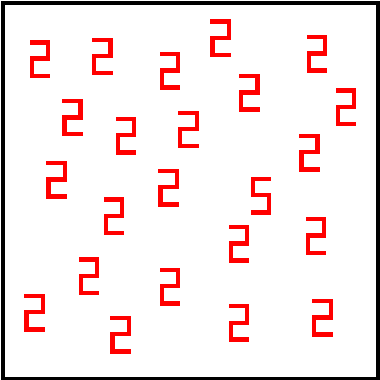
- “___-___”: time needed to find the target is very short/constant in feature search
• RT not influenced by number of distractors
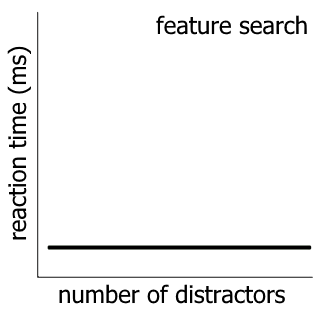
• primitives cause pop-out:
e.g., colour, brightness, orientation, length, curvature, etc.
• target location is identified in preattentive stage: search is in parallel
- “inefficient” search: conjunction and spatial configuration searches take longer
• RT increases as number of distractors increases
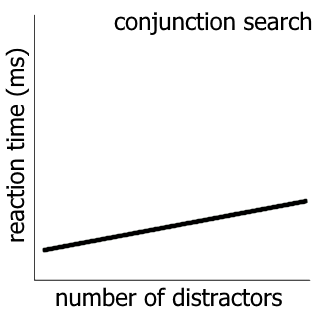
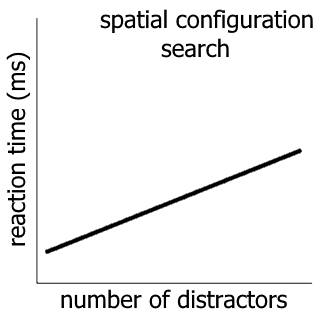
• more time is spent in focused attention stage: search is serial
Pros & cons:
![]() evidence: ________ conjunctions (conjunction errors): when attention is overtaxed, primitives may be incorrectly combined
evidence: ________ conjunctions (conjunction errors): when attention is overtaxed, primitives may be incorrectly combined
e.g., red Xs, blue Os: you may perceive a blue X
e.g., Stroop effect (1935): shows attentional inhibition of automatic cognitive processes
![]() evidence: feature present/feature absent effect: target features that are present are better detected than target features that are absent (Treisman & Souther, 1985)
evidence: feature present/feature absent effect: target features that are present are better detected than target features that are absent (Treisman & Souther, 1985)
![]() explains _______: how separate aspects of a stimulus (colour, form, motion, location) are combined into a holistic percept
explains _______: how separate aspects of a stimulus (colour, form, motion, location) are combined into a holistic percept
![]() contrary evidence: Schneider & Shiffrin (1977)
contrary evidence: Schneider & Shiffrin (1977)
- visual search task
• different-category: scan for a certain number in a field of letters
• same-category: scan for a certain letter in a field of letters
- same-category: took longer, more errors
- however, with enough practice, participants could automatically discriminate:
• arbitrary groups of letters
• real letters vs. artificial letters
• regular vs. mirror-image letters
- with practice, conjunction search can become automatic/________--contrary to FIT
![]() attention is more than just a binding agent
attention is more than just a binding agent
Application of visual search (Wolfe & colleagues, 2005):
- when targets in visual search are rare, do ______ increase?
e.g., radiological screening for breast cancer, or airport baggage screening
- experiment simulated baggage screening: search images for targets (tools)
a) 20 in 40 images had target: miss rate = 7%; ______ RTs
b) 20 in 2000 images had target: miss rate = 30%; ______ RTs
- repeated negative responses (“no, no, no,...”) lead to speed/accuracy trade-off: repeated responses are faster, but produced more misses
- the __________ effect: “if you don’t find it often, you often don’t find it”
- are the results the same in the real world, with real baggage screeners?
Inattentional _________: if stimulus is presented, but is not attended, it is not perceived (coined by Mack & Rock, 1998; a.k.a. “looked-but-didn’t-see” problem)
Neisser (1979):
- showed videos of two overlapping basketball teams
- task: count the number of passes made by black-shirted team
- about 50% of viewers _______ the _____
Simons & Chabris (1999):
- showed participants a video of two teams of three basketball players
- task: count how many times the players wearing white pass the basketball
- 46% of observers ______ the _______
Attentional _____: when stimuli are presented in a series, one target stimulus interferes with the ability to detect a subsequent target
Shapiro, Arnell, & Raymond (1997):
- used rapid serial visual presentation (RSVP)
- a string of stimuli presented briefly (100 ms each)
- first target stimulus is presented (e.g., white letter)
- second target stimulus follows (e.g., “X”)
- second target unlikely to be ________
- may be due to attention being “used up” for 500 ms after an event
______ blindness: an inability to detect changes in an object or a scene
Levin & Simons (1997):
- participants told to “pay close attention” to a video of a conversation
- only 1 of 10 participants noticed any _______
Simons & Levin (1998):
- only ____ of the participants noticed a change in the stranger
- changes may be local or global, fast or slow
- however, people do notice changed sex, race, or social group
Implications:
• attention is limited: _______ awareness
• not everything presented to our senses is _________
• visual encoding must be ______